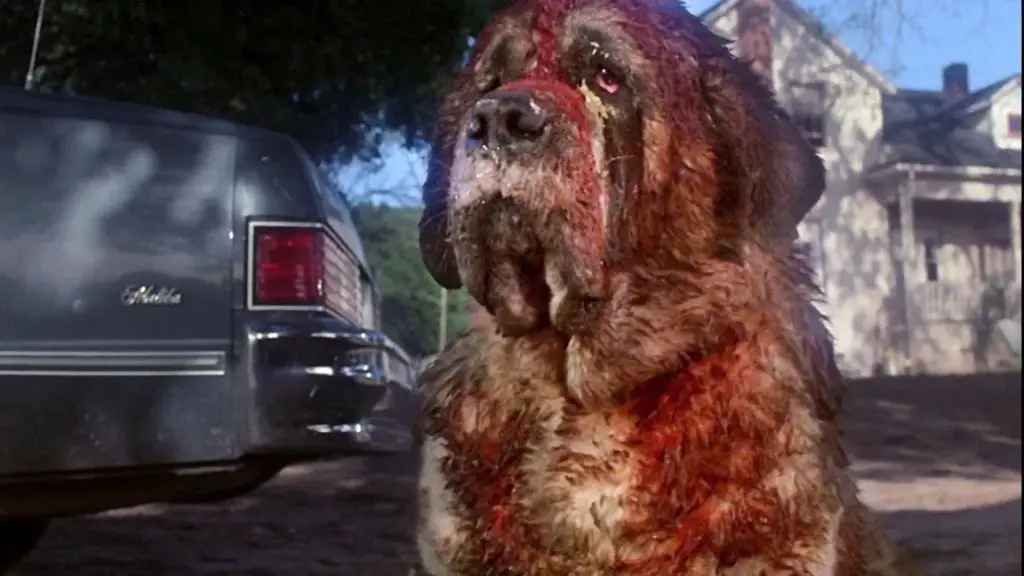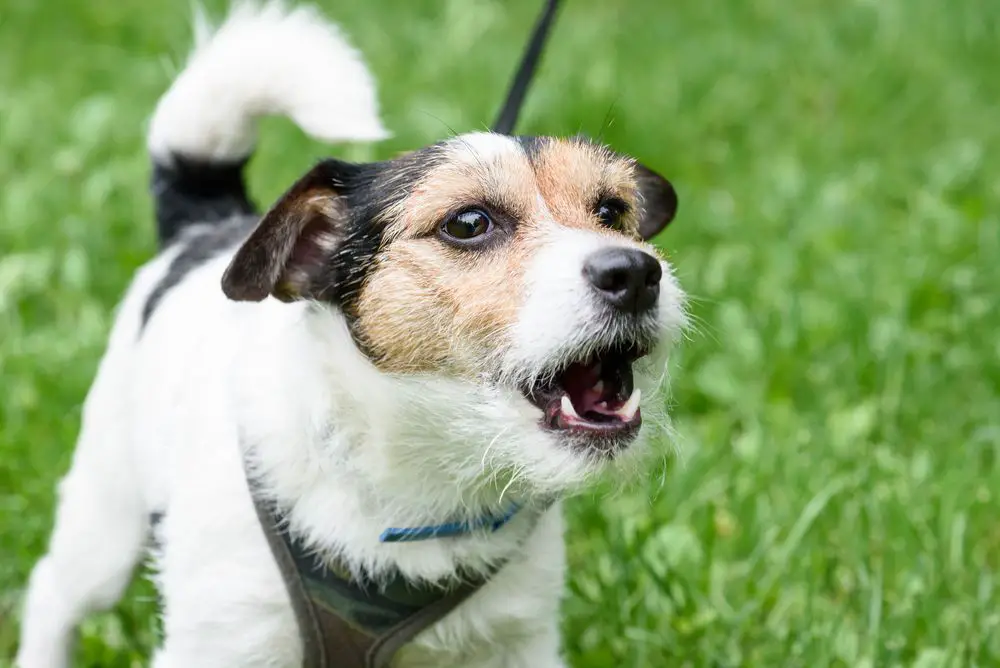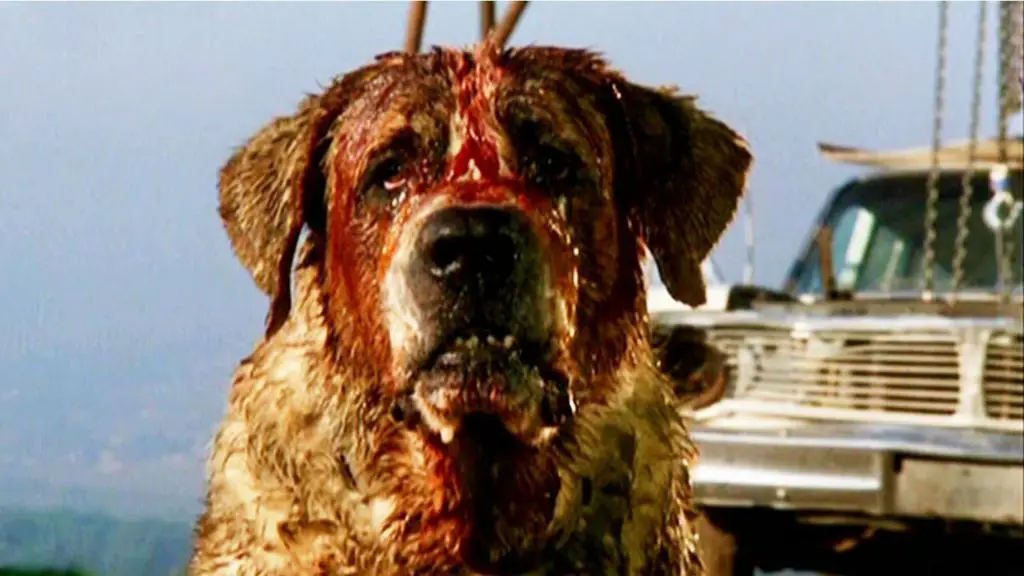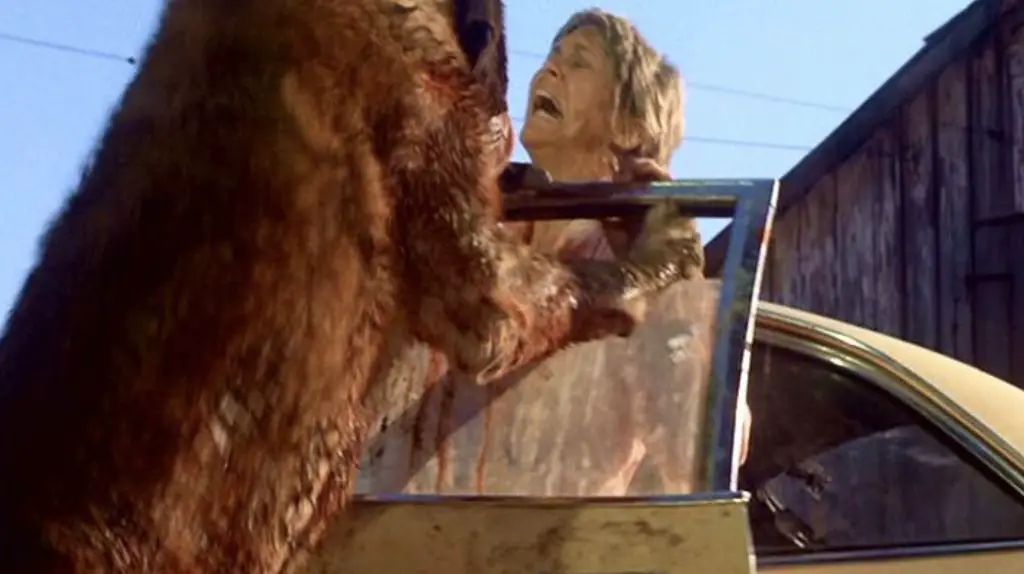Introduction
The 1983 horror film Cujo, based on the novel by Stephen King, tells the story of a rabid St. Bernard that terrorizes a mother and her young son. Though a work of fiction, the film used real dogs to portray the crazed Cujo, leading to allegations of animal abuse and cruelty on set.
Four different trained dogs played Cujo in the film. The dogs were treated well during filming, but the nature of the aggressive scenes sparked concern from animal rights activists. The filmmakers defended their practices, but rumors spread that the dogs were abused. While major incidents haven’t been confirmed, the controversy opened up debates about using animals in horror films.
About the Movie Cujo
Cujo is a 1983 American horror film based on Stephen King’s 1981 novel of the same name. The film follows Donna Trenton (Dee Wallace) and her young son Tad (Danny Pintauro) as they are trapped in their Ford Pinto while being attacked by a rabid St. Bernard. The large dog named Cujo contracts rabies after being bitten by a bat and terrorizes the residents of Castle Rock, Maine.
Other main characters include Joe Camber (Ed Lauter), Cujo’s owner; Vic Trenton (Daniel Hugh Kelly), Donna’s adulterous husband; Charity Camber (Kaiulani Lee), Joe’s abused wife; Brett Camber (Billy Jacoby), the Cambers’ young son; Steve Kemp (Christopher Stone), one of Donna’s ex-boyfriends; Gary Pervier (Mills Watson), the local sheriff; and Roger Breakstone (George ‘Buck’ Flower), a nosy neighbor.
The story follows Donna and Tad’s increasingly desperate attempts to survive inside their car as the now-rabid Cujo viciously tries to attack. Vic returns home to try and save them, while Sheriff Kemp and the other local townspeople remain largely unaware of the danger posed by the violent dog. The intense heat and Cujo’s repeated attacks push Donna and Tad to their physical and emotional limits.
The Dogs Who Played Cujo
Multiple Saint Bernard dogs were used to portray Cujo in the film. According to Screenrant, the primary dog who played Cujo was named Bang. He was trained by veteran animal trainer Karl Miller. Other dogs included Teddy and Billy (https://screenrant.com/cujo-every-animal-human-used-in-the-stephen-king-movie-explained/)
Bang was chosen for his size and calm demeanor. He went through extensive training to learn certain behaviors and reactions for the role. Positive reinforcement, treats, and patient repetition were used to condition Cujo’s menacing behaviors like snarling and pouncing. For scenes that were too dangerous, a mechanical Cujo replica was used instead (https://screenrant.com/cujo-every-animal-human-used-in-the-stephen-king-movie-explained/)
According to the New York Film Academy, the dogs who played Cujo were kept cool during filming and were not actually harmed. Their aggressive behaviors like snarling and growling were natural instincts brought out through training and cues (https://www.nyfa.edu/student-resources/the-real-dogs-behind-10-iconic-canine-roles/)

On-Set Treatment of the Dogs
The dogs who played Cujo were trained and handled by veteran animal trainer Karl Miller. According to Screen Rant, Miller ensured the dogs were treated humanely and that filming never pushed them past their limits. The dogs played in short increments and were given ample breaks in between scenes.
In an interview with Fangoria magazine, Miller stated “We never did anything to make the dogs mean or vicious.” The dogs were chosen for their playful and friendly dispositions. Miller used positive reinforcement techniques and lots of rewards to train them.
Dee Wallace, who played the mother Donna Trenton, said the dogs were very sweet and well-cared for. She never felt threatened or in danger around them. Crew members also reported the dogs were relaxed and happy on set. The animal handlers made sure the dogs felt comfortable and safe at all times.
Controversy and Allegations

There was some controversy and accusations surrounding potential abuse or harm caused to the dogs portraying Cujo during filming. Some animal rights groups accused the production of abuse, citing the intense heat and confinement the dogs faced in the car scenes.[1] However, the filmmakers and trainers strongly denied these allegations. They pointed out safety measures like cooling fans, plenty of water, and short takes to prevent overheating. The dogs played in rotation and went home with their trainers every night.
The production team maintained Cujo was filmed ethically, with certified trainers monitoring the dogs and ensuring good treatment. They emphasized creating a realistic movie portrayal while keeping the dogs safe and comfortable. The makers said Cujo’s snarling onscreen was acting, not signs of abuse. Ultimately, investigators found no evidence of wrongdoing. But the rumors persisted and sparked debate on safe, ethical ways to feature animals in films.
[1] https://helterskelliter.wordpress.com/2020/07/03/the-monster-you-know-why-cujo-1981-is-terrifying/
Expert Analysis on Dog Behavior
Dog experts and trainers who worked closely with the dogs portraying Cujo reported no signs of mistreatment or distress. The filmmakers took steps to ensure the dogs’ welfare. According to American Humane, an organization that monitors animal safety for films, the dogs portraying Cujo were trained using only positive reinforcement. They exhibited no behavioral issues and remained friendly with cast and crew throughout filming.
Furthermore, the animals were given ample breaks, access to shade and water, and constant supervision from trainers. Aggressive behaviors like barking and snarling were achieved through acting cues and editing techniques rather than actual aggression. The dogs showed no fearful reactions or avoidance behaviors that would indicate mistreatment.
Leading canine behaviorists agree the training and filming conditions ensured the dogs’ wellbeing. The portrayal of “Cujo” was an acting role, not an actual dangerous dog. With proper precautions, dogs can participate safely in films requiring aggressive depictions.
Regulations Around Using Animals
In the 1980s, there were some regulations around using animals in film productions, but oversight was still developing. The American Humane Association (AHA) had begun monitoring the treatment of animals in films in the 1940s. They published guidelines and added the “No animals were harmed” disclaimer to films that adhered to their standards (Source). However, monitoring on film sets was not yet mandatory.
Some high profile controversies emerged in the 80s that highlighted mistreatment and led to increased public concern. Films like Cannibal Holocaust (1980) and Heaven’s Gate (1980) included scenes of real animal cruelty and death (Source). This increased pressure for more comprehensive laws and enforcement around the humane treatment of animal actors.
Legacy and Impact
The movie Cujo sparked significant debate and controversy around the treatment of the dogs during filming, leading to calls for stronger regulation of animal welfare in Hollywood productions. Despite assurances from the filmmakers that no animals were harmed, allegations of mistreatment led to protests and boycotts. This public outcry put pressure on the industry to re-examine its standards for animal welfare.

In the years following Cujo’s release, new guidelines and regulations were introduced in Hollywood aimed at ensuring proper treatment of animals on sets. For example, the American Humane Association’s “No Animals Were Harmed” program was founded in part as a response to the issues raised by Cujo, providing oversight and protection for animals used in films and TV productions.
While questions still remain about the off-screen treatment of the dogs in Cujo, the film served as a catalyst for positive changes in Hollywood. Its legacy demonstrates the ability of public engagement around animal welfare to drive reform, even in major industries like filmmaking. The debate sparked by Cujo led to real improvements in safeguarding animal well-being during production, a benefit still seen decades later.
Overall, the longterm implications of Cujo for animal welfare in Hollywood have been significant. Though controversial, it helped shine a spotlight on the need for proper standards, oversight, and accountability when using animals on sets. This paved the way for stronger protections that remain in place today.
Sources:
– https://joneslauren94.wordpress.com/2015/03/27/no-animals-were-harmed-in-the-writing-of-this-post/
– https://www.animallaw.info/article/cujo-goes-college-use-animals-individuals-disabilities-postsecondary-institutions
Conclusion
In summary, despite some controversial allegations from a trainer, there is little evidence to suggest the dogs who played Cujo in the 1983 film were mistreated or harmed during filming. The movie used several trained dogs and careful filming techniques to create the illusion of a rabid St. Bernard without endangering the animals. While Cujo received criticism from some animal rights groups at the time, standards and oversight for using animals in films have greatly improved since then. Looking back now, it seems the dogs were treated mostly humanely, though there were likely some questionable choices made by trainers that would not be allowed today. Overall, the legacy of Cujo endures more for its thrills and chills rather than any real animal abuse on set. With proper precautions, animal actors can participate in filmmaking without being harmed.
In the nearly 40 years since Cujo was filmed, significant advancements have been made in humane treatment of animal actors and strict guidelines enforced to prevent abuse. As a result of increased oversight and improving attitudes around animal welfare, it’s become far less common for animals to be put in dangerous situations or harmed for the sake of entertainment. While extreme animal thrills may still show up in some movies, most major productions today work closely with qualified experts to ensure animal actors are safe and well cared for. With reasonable safety protocols in place, there’s no reason dogs and other animals can’t appear in films without suffering any mistreatment. Though Cujo had its controversies, it helped lead to positive changes in how animal actors are protected and respected.
References
Cujo (1981) directed by Lewis Teague and based on the Stephen King novel stars Dee Wallace, Daniel Hugh Kelly and Danny Pintauro. The film follows Donna and her son Tad as they are trapped by the rabid St. Bernard named Cujo.
To portray Cujo, several Saint Bernards were used during filming. The primary dog who played Cujo was a trained dog named Bark Fairburn Contracted from Birds & Animals Unlimited. The American Humane Association oversaw the on-set treatment of the dogs, and reported no animals were harmed during production.
While there were unconfirmed reports that the dogs were mistreated, the American Humane Association refuted these claims and confirmed the dogs were well cared for, given ample rest between takes, and never placed in danger.
Animal experts note that rabies in dogs is exceptionally rare, and does not cause dogs to become aggressive. Rabid dogs exhibit symptoms like fever, seizures and paralysis. A dog with rabies would likely be too sick to act aggressively.
The use of animals in film production is regulated to ensure safety and proper care. The American Humane Association works to monitor animal action and prevent any mistreatment.
Cujo leave a legacy as a notable adaptation that thrillingly captured the terror of its novel source material. While rumors of on set mistreatment circulated, oversight organizations confirmed the animal actors were treated humanely throughout production.

References
List of sources referenced in the content above.